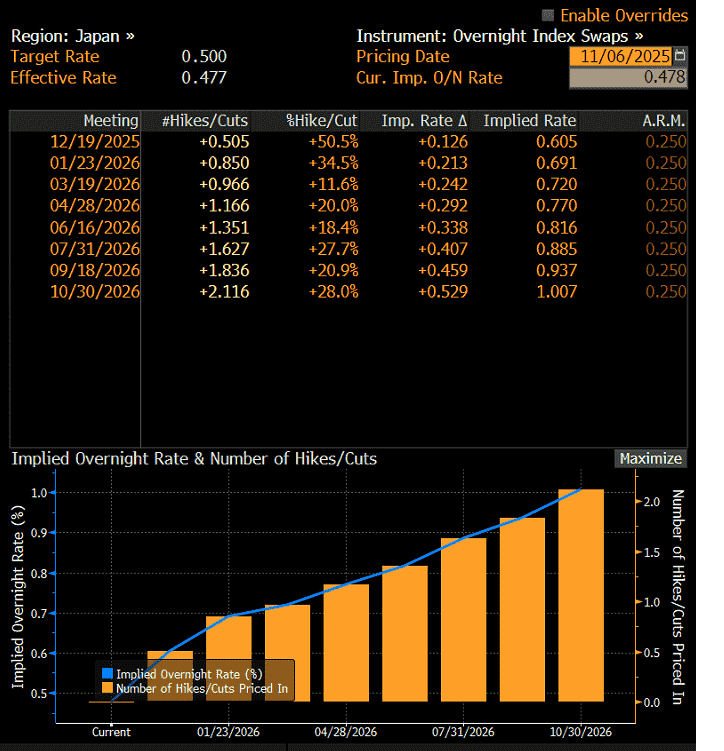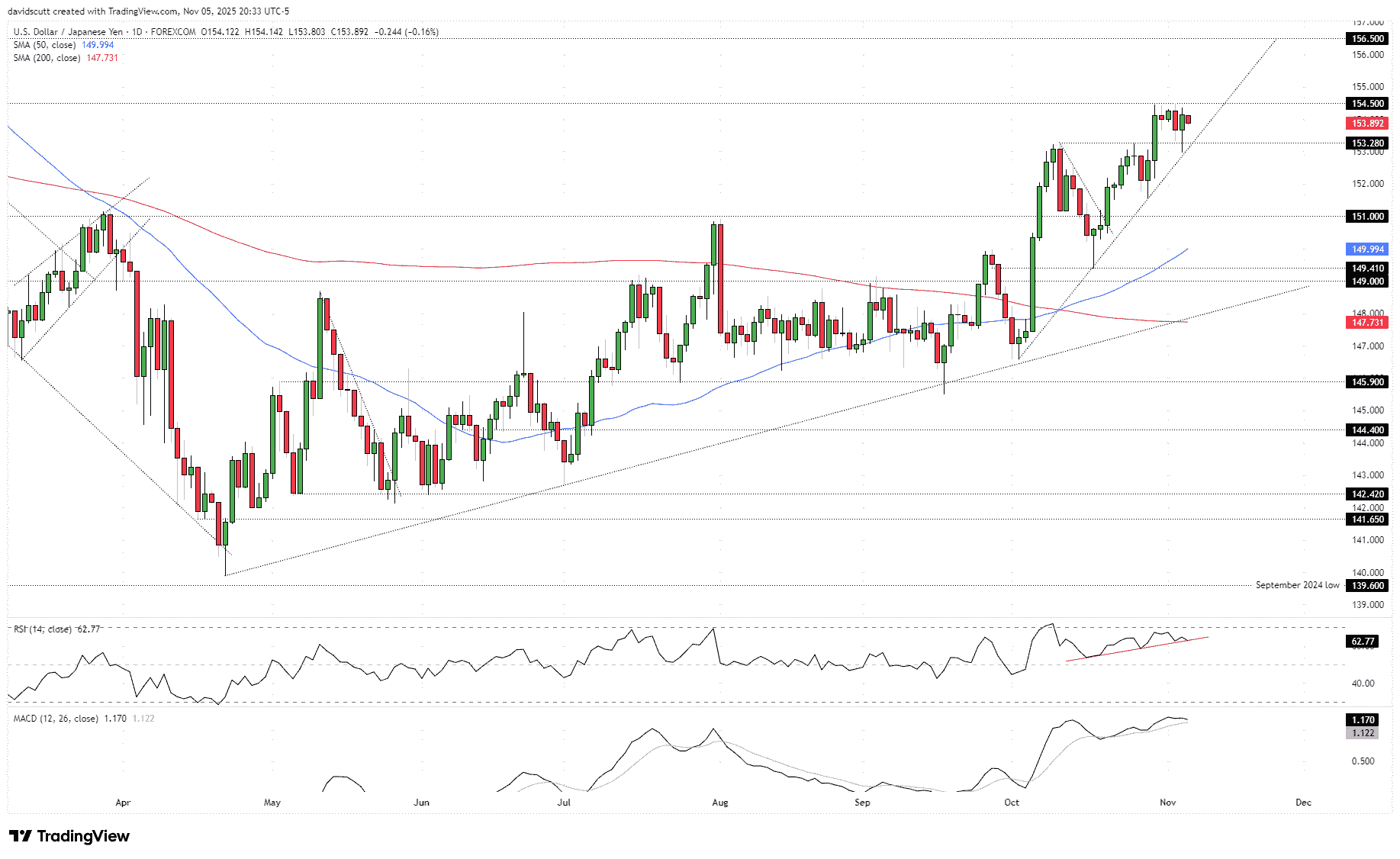BofA sees higher gold prices, likely to hit $5,000/oz in 2026
The BOJ wants wage momentum before hiking, but today’s data didn’t deliver. With political cover to wait, a December hike is far from guaranteed.
- Japan’s real wages fell for a ninth consecutive month in September
- Governor Ueda signals no urgency to tighten before spring wage talks
- Political pressure on BOJ remains low despite inflation overshoot
- USD/JPY stalls at 154.50 resistance despite bullish trend
Summary
Japanese wages continue to go backwards after inflation, casting doubt on the BOJ’s ability to generate sustainable, demand-driven price pressures. Governor Ueda’s upcoming speech could be pivotal, especially following an upside surprise Tokyo CPI print last month. Yet with political leaders urging caution and wage growth tepid, the BOJ is not under pressure to hike despite continued inflation overshoots. USD/JPY’s recent rally is showing signs of exhaustion, with resistance at 154.50 proving tough to overcome— a bullish break may require a hawkish shift in US rate expectations.
Japan Real Wages Decline Again
Japan’s real wages declined again in September, extending their losing streak to a ninth consecutive month as inflation continued to outpace pay growth. While nominal cash earnings rose 1.9% from a year earlier, real wages fell 1.4% after adjusting for inflation, underscoring the strain on household purchasing power. With consumption making up the bulk of Japan’s economy, the persistent erosion of real incomes remains a major obstacle to generating the kind of demand-driven inflation the Bank of Japan (BOJ) wants to see.
Source: TradingView
BOJ Keeps its Options Open
There’s little sign of meaningful wage acceleration that might shift that dynamic. Governor Ueda’s recent comments about wanting to see “momentum” in the early stages of the 2026 spring wage talks suggest the BOJ is in no rush to move, implying a window in the first quarter of next year before the bank can make a confident assessment. Ueda’s caution is arguably justified, given large annual wage increases agreed with unions over the past two years have yet to translate into similar outcomes across the broader economy.
Still, the BOJ’s somewhat unusual announcement last week that Ueda will deliver a speech on December 1—just days after the next Tokyo inflation report—is notable. The timing could give him optionality to prime markets for a potential December move, particularly after the last Tokyo release produced a sharp upside surprise in both core and headline readings.
As things stand, swaps markets put the implied probability of a 25bp rate hike at the BOJ’s December 19 meeting at 50%, effectively deeming the outcome a coin toss. By March—when spring wage negotiations will be in full swing—a full hike is now all but fully priced.

Source: Bloomberg
Intervention Threat Appears Weak
While Ueda’s speech looms as a key event ahead, Prime Minister Takaichi’s remarks this week reinforced the sense that political pressure on the BOJ to act remains low. She said Japan is only halfway toward achieving sustainable inflation accompanied by wage gains, signalling she doesn’t want to push the bank into tightening policy prematurely. It’s a stance consistent with her reputation as a policy dove in the mould of former Prime Minister Abe, hinting she’s not willing to risk weakening the economy and strengthening the yen despite inflation remaining well above the BOJ’s 2% mandate.
Her dovish stance makes it difficult to take her finance minister’s warnings about yen movements too seriously, given USD/JPY remains a well-known play on rate differentials. Unless backed by fundamentals—either through higher Japanese yields driven by a more hawkish BOJ or a meaningful decline in US Treasury yields—any intervention from the BOJ at the government’s request risks being ineffectual.
Source: TradingView
Finance Minister Satsuki Katayama reiterated on Tuesday that the government would continue to monitor foreign exchange movements with a high sense of urgency as the yen slipped to fresh eight-month lows near 154.50 per dollar. Her latest comments mirrored those delivered last Friday, suggesting Tokyo’s verbal warnings may be as far as it goes for now.
USD/JPY Bullish Move Stalls

Source: TradingView
Even before the threat of potential intervention, the bullish move in USD/JPY over the past six weeks is showing signs of fatigue, struggling to break through resistance at 154.50 in recent days, as was the case on a separate occasion in February. While the price remains in an uptrend and bounced strongly from support starting from 153.28 down to 153 on Wednesday, bulls would want to see 154.50 taken out quickly—otherwise, the pair risks breaking through the October 2 uptrend.
While RSI (14) and MACD remain firmly in bullish territory, the former is demonstrating bearish divergence with price and the latter is starting to curl over toward the signal line. This hints that upside pressure may have peaked, adding to the need for caution about getting too bullish around these levels.
Key levels above include 154.50 and 156.50. On the downside, a break of the intersection of uptrend and horizontal support just above 153 would open the door for a possible run toward 152 and 151, where the pair did plenty of work either side of earlier this year.
